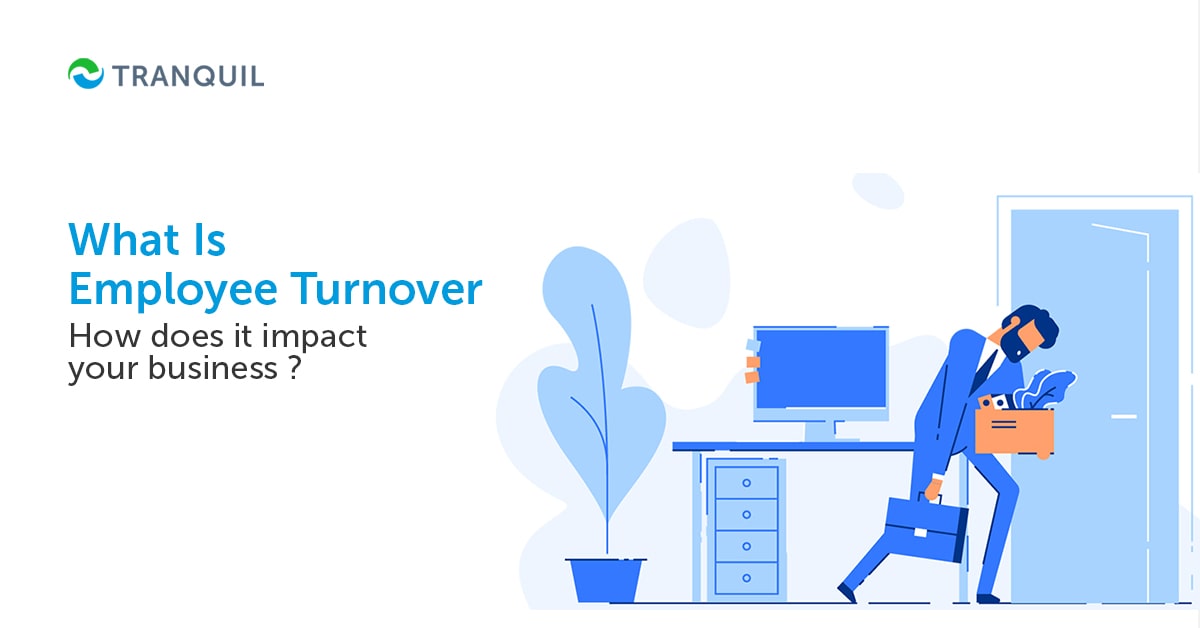
The success of a company depends to a great extent on how well it recruits, inducts, manages, and rewards its employees.
You cannot afford to do guesswork here; if you leverage the power of data, you can get all of it right, and be successful.
You can be proactive and organize programs for career development, and compare total remuneration metrics against the cost of bringing new employees in the place of top-performing ones.
Employee turnover refers to the number of employees quitting a company in a specific time period.
Usually, this is a one-year period.
It can be measured pan-organization or department-wide – and even demographics-wise; like males or females, which age groups, which designations etc.
ALSO READ: Benefits of Having an Employee Self-Service System
Computing the employee turnover rate may sound simple, but there are multiple factors that can tilt the scales.
The HR department should evaluate the rates of attrition and the reasons for the same.
If they are unable to do so, they can consult external human capital management specialists and get insights from them.
According to HR specialists, you need to calculate the turnover rate of employees by dividing the number of employees leaving in a specific period, say a month by the average number employed on the payroll in that same time period, and then multiply the figure by 100.
ALSO READ: Common HR Mistakes and Tips to to Avoid
This means you need:
So, we have the formula:
Number of separations / average number of employees x 100 = Employee turnover rate
Therefore, for a company with an average of 250 employees working in a particular month, and 30 employees go, the turnover rate would be 12%, when we follow the formula:
(30/250) x 100 = 12%.
Remember to exclude temporary employees or layoffs on either side of this equation, which can skew your results and give you a higher employee turnover rate than the actual.
ALSO READ: HCM Vs. HRM

Replacing skilled employees can be expensive; which is why, businesses implement measures to decrease employee turnover, whether voluntary or not.
The cost of hiring, onboarding, and training a new employee can be nearly double the salary of the existing employee.
If you apply the formula, if you have to replace an employee who earns SAR 100,000 a year, you may have to spend up to SAR 200,000.
Let us continue with the example of turnover ratio.
You have 12% turnover; if the average salary is SAR 80,000, this means you could have to spend up to SAR 160,000 each on the 12 workers you replace per year.
If you’re experiencing high turnover because of wrong hiring and having to terminate the employee almost immediately, it’s a case of financial and productive loss.
It also impacts the employee morale negatively, and affects the quality of work done by others.
Therefore, the cost of employee turnover is not limited to the financial aspect.
ALSO READ: Must-Have HRMS Modules and Features
Employee turnover is mainly of two kinds – voluntary and involuntary.
It is voluntary turnover refers to the employee choosing to quit; the reasons could be any – better job opportunity elsewhere, dissatisfaction at your company, conflict with coworkers, moving to another city, disability, and so on.
There could also be instances where employees move from one department to another; in this case, there is turnover for a particular department but not for the organization as a whole.
When employers dismiss an employee for under-par performance, bad attitude, fraudulent activities, or any other reason, it is termed involuntary turnover.
Turnover is completely normal for any business and cannot be eliminated; however, you can keep it low.
Now what constitutes a low turnover depends on the industry, size of the company, region, and type of job.
This means a retail chain cannot compare their turnover ratio with a bank, and so on.
ALSO READ: Detailed Guide on ROI on ERP Implementation

Now that we’ve seen what employee turnover is and how to calculate it, let us look at the main reasons for employee turnover:
Industry experts agree that the main reasons for employees moving to other companies are better pay, more holidays, great benefits, prospects of promotion, conducive work atmosphere, and supportive superiors.
Turnover can be stemmed significantly when a company is prepared to hike overall remuneration, be more flexible, ensure their managers are effective and take quick remedial action when they notice above-average attrition in any particular department.
ALSO READ: What is Business Process Improvement?
A company that does not value its employees and care about their wellbeing is a poor paymaster, or does not have a positive work culture and atmosphere, is certainly going to have a higher turnover rate than those companies who do implement these things.
Mind you, however, there is no way you can have zero turnover.
Some attrition is anticipated, and normal. It is when the turnover takes place for the wrong reasons and takes place at an unreasonable rate that is bad.
Let’s take a look at the most common causes of employee turnover:
ALSO READ: Ways to Improve the Procurement Process
When you understand the reasons for employee turnover, you can take the requisite action to maintain your staff at the levels you need.
Multiple factors impact turnover, and so the benchmark level of turnover depend on those factors.
It is critical that businesses consider industry related as well as individual factors to measure their turnover rate, and evaluate the results to make informed decisions to bring down that rate.
You cannot look at turnover rates in isolation; you need the context. Certain industries have higher attrition than others – like hospitality, ITES, retail, etc.
A company should compare its results with other businesses in the same industry to get an idea of how many employees churn they have.
If you take the example of retail stores, you’ll find that there are many newcomers, seasonal workers (more help is needed for the busy season), and part-time workers.
But such businesses can also reduce turnover by improving employee satisfaction with say better benefits, working hours, discounts on store products, and so on.
In general, high turnover rates are definitely problematic.
It could either be because of improper hiring, poor culture, bad compensation structure, inadequate benefits, incompetent managers, or any other factor.
ALSO READ: Importance of Capacity Requirement Planning

Yes, it is possible to bring down the employee turnover rates to acceptable levels.
Here are some tips:
Make sure that your managers know what is expected of them to stem employee turnover.
Managers must be able to understand personal motivations and what encourages employees to stay or leave, to be more productive, proactive, loyal, and so on.
It is vital that managers report on these matters regularly and keep top management in the loop regarding the causes of employee churn.
Each employee who leaves is likely to have a completely different set of reasons.
ALSO READ: What is Job Costing?
Most employees want to move up and progress, and earn new skills, and of course, better pay.
They may not be aware of such opportunities existing within the organization unless you publicize them.
When you do communicate openings, most workers will be happy to grab the opportunity as they are likely to be more comfortable continuing in the same organization.
This helps the business save on recruitment expenses as well.
If there’s more attrition in any specific department it is essential you find out the cause; is it unsupportive managers, dissatisfaction with their roles, not getting along with colleagues, unhappy with salary or benefits, or any other reason.
Hold town halls and conduct surveys to really listen to your employees; after all, communication is a two-way activity.
You can highlight company vision and regulations, and give an ear to employee problems; recognize employees for their good work, and announce programs for professional development, newly introduced benefits, and so on.
ALSO READ: How ERP Can Improve Business Efficiency?
![]()
A robust, feature-rich HR management software like Tranquil can help you bring down employee turnover significantly by
ALSO READ: Common ERP Challenges
ALSO READ: Need of Having HR & Payroll Management Software in SMEs?
ALSO READ: What is Product Bundling?
With the right HRMS like Tranquil, you can provide a better employee experience, improve engagement and satisfaction, and reduce employee turnover rates. This can help your company save costs and improve productivity across the organization. Tranquil can help you keep your employees happy and productive. If you’re not sure yet, simply schedule a demo at a time of your choosing, and we’ll be happy to show you how.